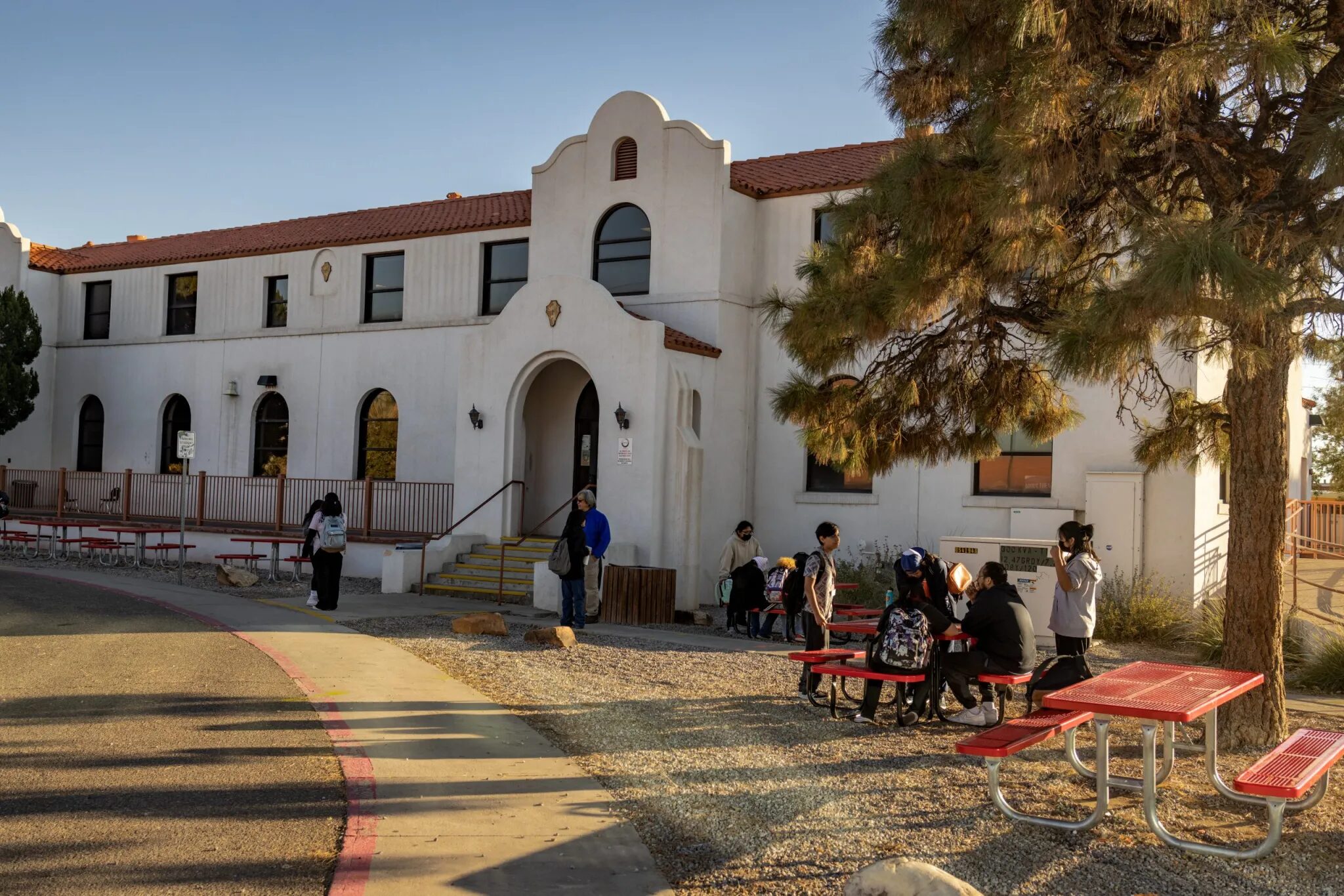This story was produced by The Hechinger Report, a nonprofit, nonpartisan news outlet focused on education.
ALBUQUERQUE, N.M. — As their teacher pounded his drums, belting the lyrics to the Native folk rock song “NDN Kars,” middle schoolers Eli, Izzy and Manin rehearsed new guitar chords for an upcoming performance.
“I got a sticker that says ‘Indian Power,’” teacher Luke Cordova sang. “I stuck it on my bumper. That’s what holds my car together.”
Inside a neighboring greenhouse, a group of school staff and volunteers prepared to harvest herbs and vegetables for students to use in medicinal teas and recipes during science lessons on local ecology. Meanwhile, in a 19th century schoolhouse next door, eighth graders in a Native literature class debated the consequences of racism on college campuses. “Remember,” teacher Morgan Barraza (Akimel O’odham, Kawaika, Apache, Thai) told them, “power is not all with the decision makers. You as a community have power, too.”
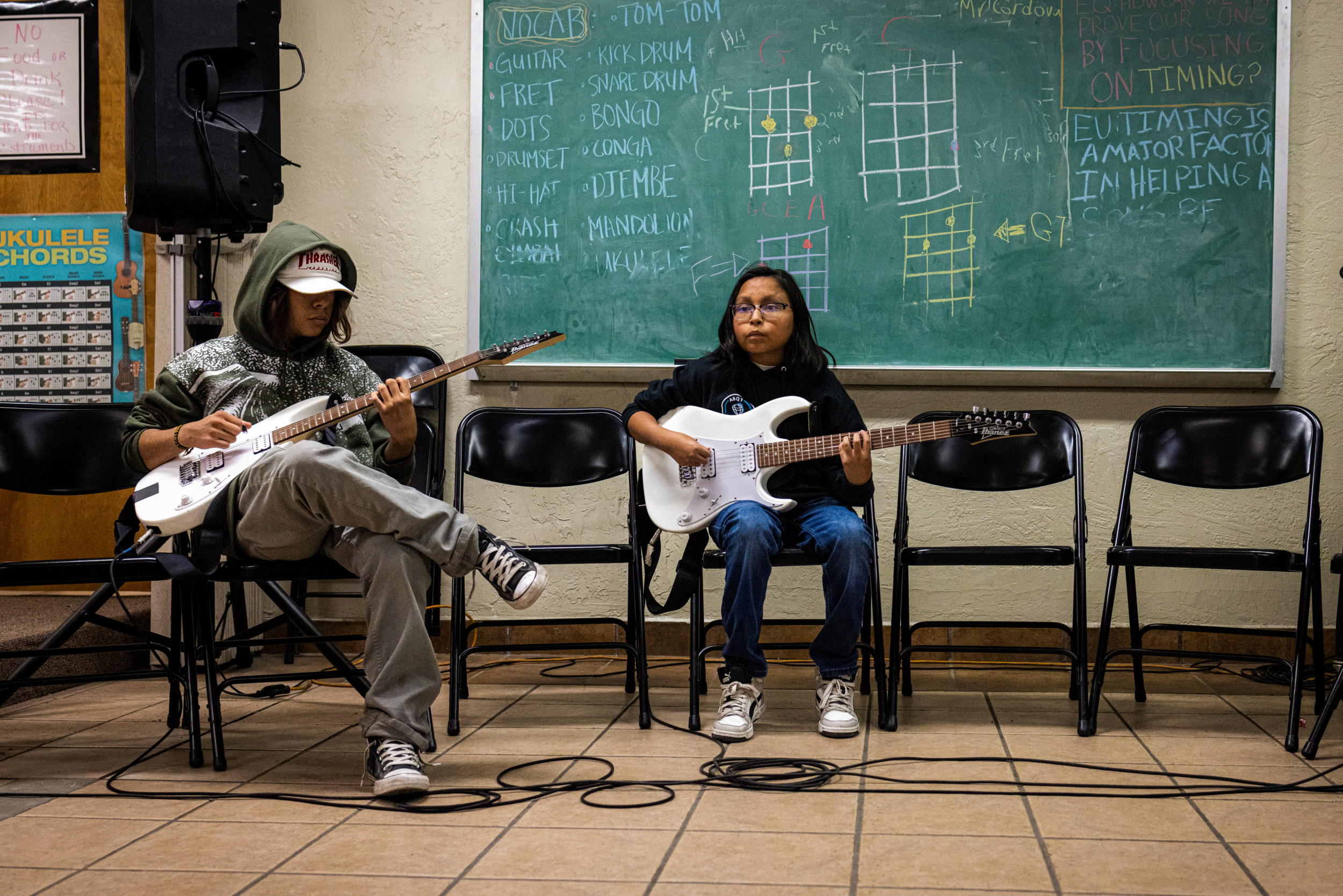
Sharon Chischilly/For The Hechinger Report.
Middle schoolers Eli and Manin practice guitar chords for the Native folk rock song “NDN Kars” at the Native American Community Academy in Albuquerque in Nov. 2024.
Once the site of an Indian boarding school, where the federal government attempted to strip children of their tribal identity, the Native American Community Academy (NACA) now offers the opposite: a public education designed to affirm and draw from each student’s traditional culture and language.
The charter school, NACA, opened its doors in 2006. Today, it enrolls roughly 500 students from 60 different tribes in grades K-12, bolstering their Indigenous heritage with land-based lessons and language courses built into a college preparatory model. High schoolers at NACA graduate at much higher rates and tend to outperform their peers in Albuquerque Public Schools — which authorizes the charter — and throughout New Mexico. Over the past decade, NACA’s academic track record and reputation with families and tribal leaders has spurred the creation of a network of schools designed to overhaul education for Native students across the American West.
The Native American Community Academy network, which numbers 13 schools in five states, has big plans but faces growing pains.
At 13 campuses in five states, the NACA Inspired Schools Network supports tribal communities that have found little support in traditional K-12 systems and want academic alternatives that reflect their hopes and expectations for the next generation. Each school approaches that mission very differently, and with varying results. Some have struggled to keep their doors open, testing the Albuquerque-based network’s ability to sustain its success beyond the flagship school. Still, network leaders plan to continue expanding and hope to present the NACA model as a way to grant Indigenous families the self-determination and sovereignty that has been denied to them for generations.
“In 150 years, we moved from a foreign, abusive, violent structure to now, where maybe our communities have something to say about where education is going,” said Anpao Duta Flying Earth (Lakota, Dakota, Ojibwe, Akimel O’odham), the network’s executive director. “We’re leading these schools. We’re in the classrooms. It’s not just maintaining status quo. It’s how we’re pushing the edge of what’s possible.”
[Related: 3 Native American women head to college in the pandemic. Will they get a sophomore year?]
NACA was born out of an urgent need to reimagine education for Indigenous youth: In 2005,three quarters of Native American students graduated on time in the Albuquerque school district, compared to 87 percent of all students, according to state data. Only about 1 in 4 students identifying as American Indian tested proficient in math, while proficiency rates in reading and science hovered closer to 40 percent. A string of suicides in the city’s Native communities, especially among youth, shocked educators.
In response, Native administrators within the district started meeting with families, college graduates and tribal leaders to discuss what a better education for Native students might look like. More than 200 people weighed in, often sharing their poor experiences in traditional schools, such as pervasively low expectations and a lack of cultural awareness among teachers. Community members prioritized three things in their dream school for Native youth: secure cultural identities, college preparation and holistic wellness.
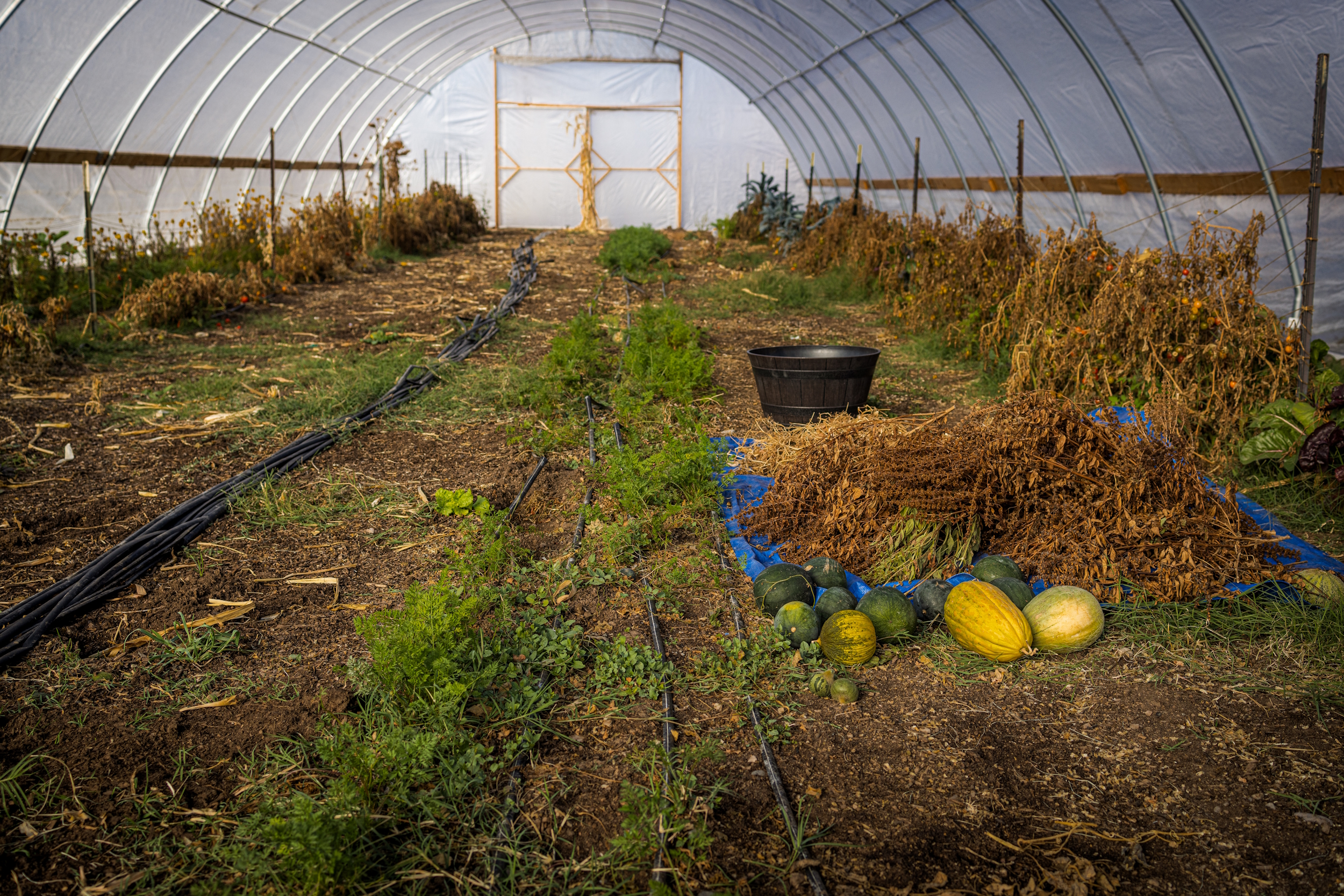
Sharon Chischilly/For The Hechinger Report.
Students at the Native American Community Academy take part in land-based lessons, some in the school’s greenhouse, to learn about local ecologies, cultures and practices. At a nearby farm in Albuquerque, students can also learn about agriculture and related industries.
Those conversations prompted Albuquerque Public Schools to authorize NACA as its first charter. Today, courses at all grade levels include Indigenous history, numeracy, land-based science and language classes in Keres, Lakota, Navajo, Tiwa, Spanish and Zuni. About two-thirds of the school’s teachers are Native American, with many alumni now leading classrooms.
NACA requires students to take at least two college-level courses and earn internship credit. Last year, nearly 80 percent of graduates enrolled in college, up from 65 percent for the class of 2022. The school also tracks college completion rates, with 59 percent of the class of 2012 finishing within six years. Since then, the numbers have slipped to the single digits, with just 5 percent of the class of 2016 finishing within six years, according to a data analysis from the charter school network. (School officials said the decline is due to incomplete data.)
Younger students attend the K-8 campus on the former boarding school site, while the high school is located in a gleaming new tower nearby at the Central New Mexico College.
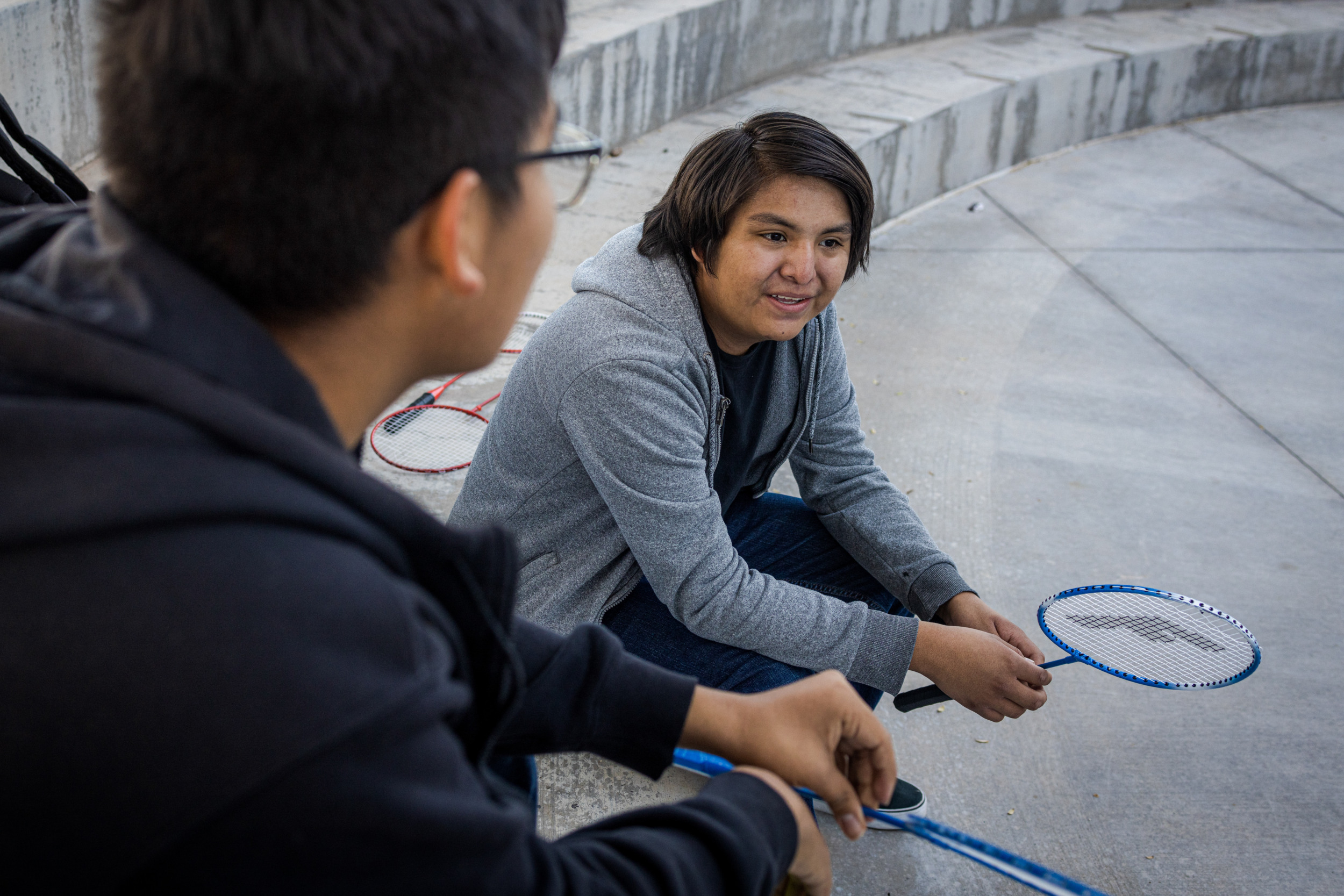
Sharon Chischilly/For The Hechinger Report.
Tyshawn, center, takes a break with his friend Joshua during lunch at the high school campus of the Native American Community Academy in Albuquerque.
During a lunch break, 11th graders Joshua, a Navajo Nation citizen, and Tyshawn, from the Laguna Pueblo, volleyed a badminton birdie under the tower’s shadow. Both are recent transfers to NACA — Tyshawn from a private Catholic school and Joshua from a traditional public high school.
“There was nothing like this. No language class, nothing,” Joshua said of his previous school. Discussions of tribal culture were limited to a few isolated craft projects during a history unit and inaccurate portrayals of Indians at the “First Thanksgiving,” he recalled.
“Yeah, not at my school,” Tyshawn agreed, chuckling. “You had to learn that experience yourself.”
“I was the ‘only’ a lot,” added Joshua, referring to his Native identity. “We fill an entire school here.”
[Related: Schools bar Native students from wearing traditional regalia at graduation]
It’s only recently that the U.S. has fully acknowledged its long history of using education as a weapon against tribes. An investigative report released by the U.S. Department of the Interior in May 2022 identified more than 400 Indian boarding schools, across dozens of states and former territories, as part of a system that directly targeted children “in the pursuit of a policy of cultural assimilation.”
The investigation found evidence of at least 53 burial sites for children. Schools renamed students with English names, cut their hair and punished them — through solitary confinement, flogging and withholding food — for speaking Native languages or practicing their traditional religions. Manual labor was a predominant part of school curricula, but often left graduates with few employable skills.
“We continue to see the evidence of this attempt to forcibly assimilate Indigenous people in the disparities that communities face,” U.S. Secretary of the Interior Deb Haaland, a citizen of the Laguna Pueblo in New Mexico, said at the time of the report’s release.
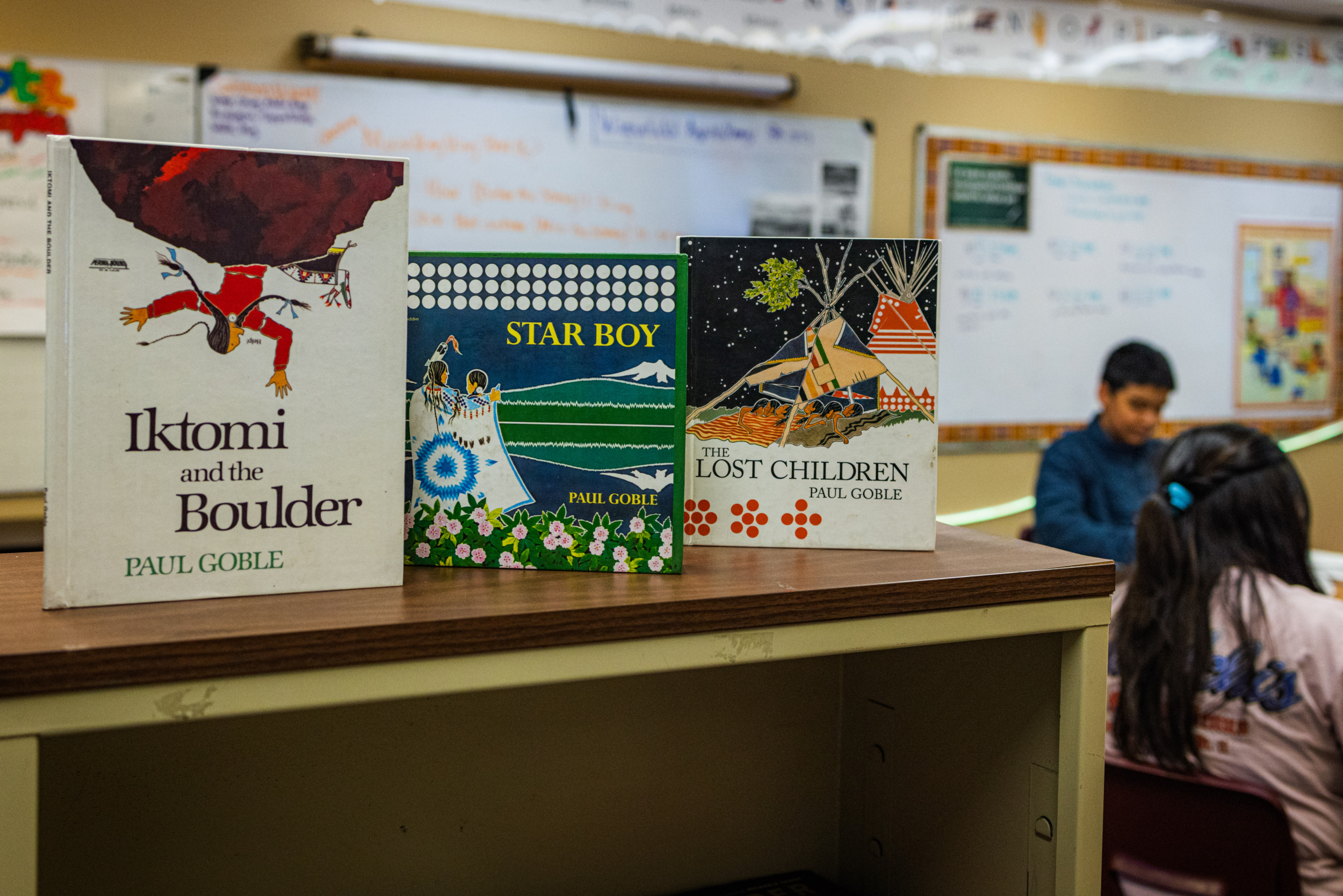
Sharon Chischilly/For The Hechinger Report.
Native American literature and stories play a central role for students and teachers at the Native American Community Academy in Albuquerque. Since its opening in 2006, the charter school has inspired the launch of similar schools in other tribal communities.
According to a 2019 national survey, close to half of American Indian and Alaska Native students reported knowing “nothing” or only “a little” about their cultural heritage. A majority — between 83 percent and 91 percent — of fourth and eighth graders in the survey said they could not speak or read in their heritage language, or reported knowing a few words or phrases at most. Other studies have found significantly higher child poverty rates, lower graduation rates and lower performance on standardized exams for Native students.
As the state of education for these children continued to languish, the U.S. Department of Education in 2018 pushed for the expansion of high-quality charter schools meant to serve Native communities, among other groups it deemed educationally disadvantaged and underserved by the existing charter sector. It later published, in partnership with the National Indian Education Association, a guide to help founders and supporters of new Native American charter schools.
“The word just hasn’t gotten out about the ability to do this,” said Todd Ziebarth, a senior vice president of state advocacy and support at the National Alliance for Public Charter Schools.
In its tally of about 4,300 charter schools with at least one Native American student, the Alliance counts at least 16 schools specifically dedicated to Native American cultural affirmation. Only a handful offer classes taught in an Indigenous language.
[Related: College tuition breaks for Indigenous students spread, but some tribes are left out]
In one of those schools, about 90 miles northeast of Albuquerque, a dozen students walked into the front office of Kha’p’o Community School with stacks of books teetering in their hands.
They’d just cleaned the shelves at the Santa Clara Pueblo library, grabbing their favorite titles in Tewa, one of the languages spoken by the Pueblo people in New Mexico. The third graders juggled the books as they traversed a courtyard ringed by adobe houses-turned-classrooms, with teacher Paul Chavarria trailing them.
Back in their classroom, Chavarria, a first-year Tewa language teacher at Kha’p’o, commenced a lesson on the language. It’s a traditionally oral language, and speakers frown on any written form. Chavarria, though, scribbled a rough translation for “stone,” “trees” and “plants” on a whiteboard to help the students learn their heritage language.
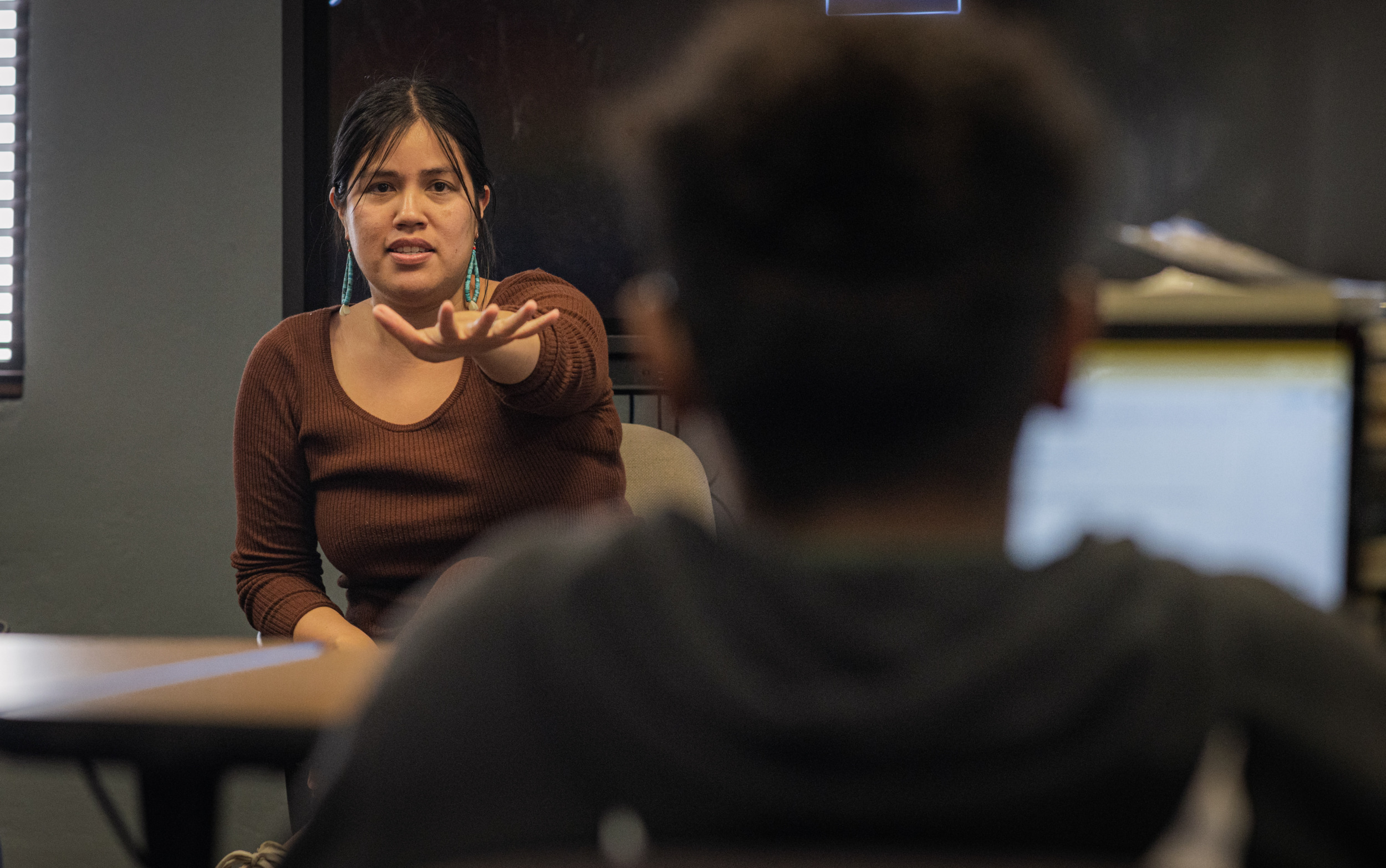
Sharon Chischilly/For The Hechinger Report.
Morgan Barraza guides a discussion with seventh and eighth graders about the consequences of racism on college campuses. Barraza teaches Native literature at the Native American Community Academy in Albuquerque.
For decades, the school (then known as Santa Clara Day School) was run by the U.S. Bureau of Indian Education, or BIE, which today operates 183 schools on 64 reservations. But in 2014, after the government-appointed principal barred a Tewa teacher from campus, tribal leaders took control of the school from the federal government, said Porter Swentzell, the school’s executive director and an enrolled member of the Pueblo. That same year, the school officially joined the NACA-inspired network as a K-6 charter school with a dual language immersion model. Today, it enrolls about 90 students.
“In our hands, language is a sacred obligation. Our job is bigger than math or ELA,” Swentzell said.. “Our story doesn’t begin with us, and it certainly won’t end with us.”
Swentzell, who served on the school board when it shifted to tribal control, recalled a rocky start for Kha’p’o. The BIE withdrew the bulk of its support, he said. Teachers and staff had to reapply for their jobs, which no longer offered salaries at the federal level. In terms of school policies, technology systems, contracts and more, “we were starting from scratch,” Swentzell said.
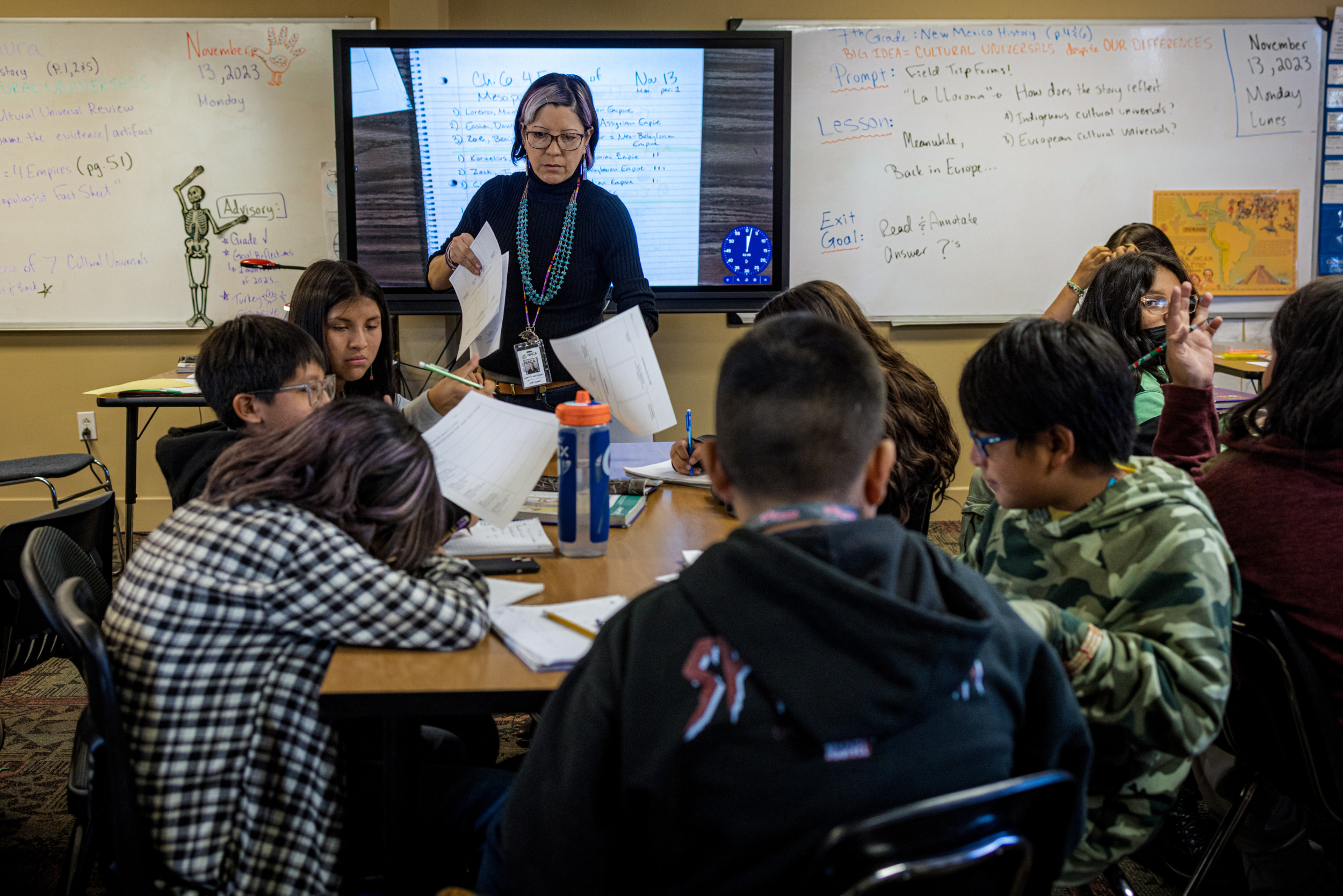
Sharon Chischilly/For The Hechinger Report.
Dorothy Sando Matsumura, a sixth and seventh grade Indigenous history teacher, passes out papers to her students during a fall class at the Native American Community Academy in Albuquerque.
Then, during the pandemic, Kha’p’o’s principal left, and enrollment plummeted from 120 students to 73, as multigenerational households kept their children at home. Half of the school’s teaching positions were unfilled, largely because of its remote location and lower salaries, according to Swentzell, who took over as head of school in 2022.
Kha’p’o wasn’t the only school in the network to lose its leader during the pandemic. And each has since struggled to get academics and operations back on track, said Flying Earth, head of the charter network. The network has tried to help: In 2022, it created a fellowship program to nurture new leaders like Swentzell, a former professor at the Institute for American Indian Arts in Santa Fe. The fellows meet regularly on Zoom and gather in person once a year, along with a lead teacher or executive team member who could potentially become principal one day.
[Related; How one Minneapolis university more than doubled its Native student graduation rate]
Indeed, as the network has grown, it has confronted the difficulty of recreating the “NACA sauce” — as the flagship’s principal called it — in each new tribal community.
Six Directions Indigenous School opened the same year as Kha’p’o, in the western region of the state near the Navajo Nation and Zuni Reservation. Data from the New Mexico Public Education Department shows that 1 in 5 students at the charter school tested proficient in science. About 1 in 10 students perform on grade level in math, with a slightly better rate in reading, at 14 percent.
Aside from academic problems, students at Six Directions have protested what they view as the school’s failure to fulfill its charter of serving Native youth. “It’s right there on all the signs: ‘This is an Indigenous school,’” said Caleb, a 14-year-old Hopi freshman. “This is supposed to be an opportunity for us to know our culture. These teachers weren’t doing that.”
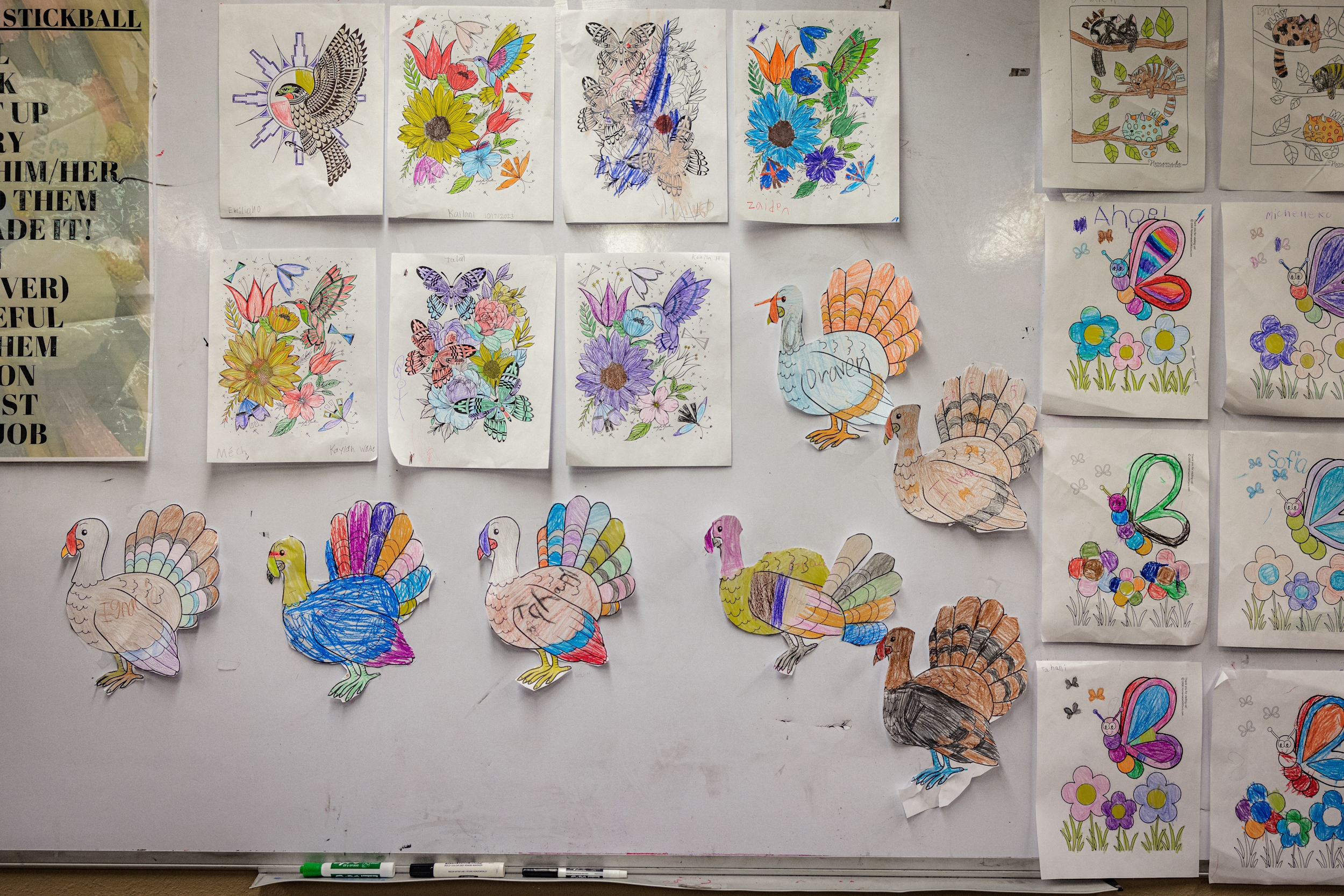
Sharon Chischilly/For The Hechinger Report.
Students at the Native American Community Academy in Albuquerque color butterflies, hummingbirds and turkeys during a Zuni language class. The charter school also teaches students in Keres, Lakota, Navajo, Tiwa and Spanish.
At the start of the school year, in August, Caleb and other high schoolers at the K-12 campus staged an impromptu walkout to protest what they described as a revolving door of teachers hired from overseas and ongoing vacancies for language and culture classes. As of late fall, the entire school had just one core teacher, in science.
[Related: The mental health and well-being of indigenous LGBTQ young people]
The walkout happened during Rebecca Niiha’s first week on the job as new head administrator of Six Directions. A former teacher who has worked on the Zuni and Navajo reservations, Niiha, who is Hopi, had admired Six Directions from afar. But she described finding its academic achievement and school climate as “degenerative” on day one.
After the walkout, two more teachers quit. Then the school’s current landlord announced it planned to sell the property, leaving Niiha unsure if she’d have to find a new location. In January, Six Directions received a warning from the state about its poor performance.
The network’s support of struggling schools, like Six Directions, can only go so far. It does not directly authorize any charter and has limited ability to hold the schools accountable.
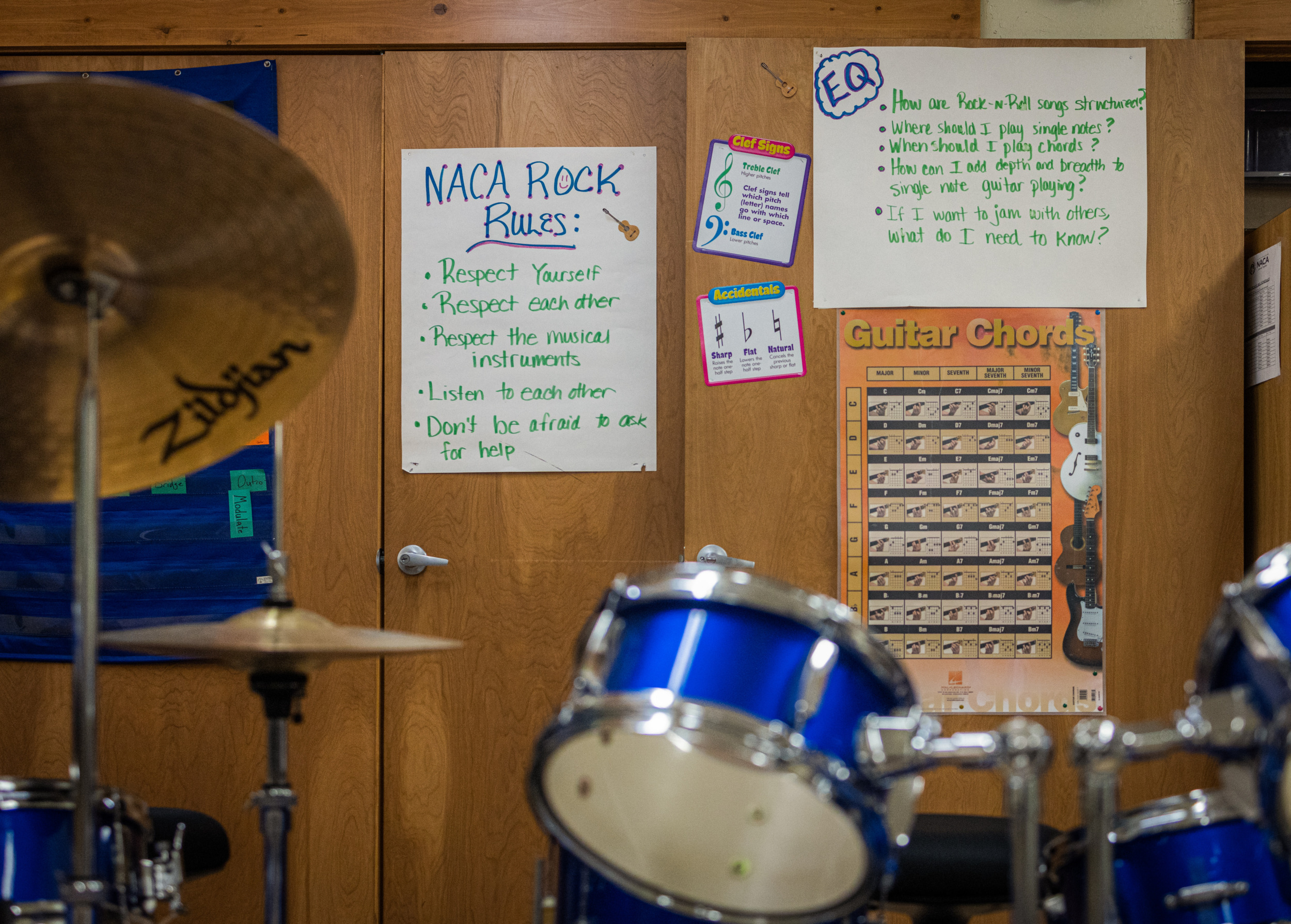
Sharon Chischilly/For The Hechinger Report.
NACA Rock and Indigenous art courses are among the electives offered at the Native American Community Academy in Albuquerque. The charter school also teaches Native literature and Indigenous languages, history and science.
Still, the network dispatches experts on finance, community engagement, student experience, curriculum and professional development. On a weekday last year, a team from the network met with Niiha to discuss options for the school’s location, training for teachers and an upcoming charter reauthorization. The network also recently partnered with AmeriCorps to place Indigenous educators in schools to offer classroom support, tutoring and mentoring, and has worked with individual tribes to certify teachers in heritage languages.
“Once a school’s created, we’re in it for the long haul together,” said Ben Calabaza, Kewa – Santa Domingo Pueblo and a spokesperson for the charter network.
Ultimately, the network wants to avoid being forced to close another of its member schools, as happened last year when Denver Public Schools shuttered the American Indian Academy. That school opened in fall 2020, at the height of the pandemic, and suffered from low enrollment and poor finances, according to the charter’s board of directors.
Flying Earth acknowledged the challenges of running a charter network that spans schools in several states. He said the charter model isn’t, on its own, a solution for poor educational outcomes for Native students. But he added that the NACA-inspired network has done what it promised: offered tribal communities a chance to have agency in building a dream school for their Native youth.
“How do we use the structures of education today, including charter schools, to lift up the genius that’s always been there, since time immemorial?” Flying Earth said, referring to the “genius” of traditional ways of knowing in Native communities. “The namesake school of NACA serves as an example of how one community did it.”
[Related: Healing the children of Horse Nations]
Many students, long after graduation, continue to contribute to that community. Some have returned as teachers and school staff. Emmet Yepa Jr., Jemez Pueblo, commuted two hours each way to attend NACA in downtown Albuquerque when he was in high school. Now, at 30, he sings every year at the school’s annual feast day — a traditional celebration among New Mexico pueblos.
“What attracted me to NACA was just the community,” he said. “They really emphasize your culture and holistic wellbeing.”
Yepa earned a Grammy Award as a child and later graduated from NACA as part of its inaugural class in 2012. From there, he went on to the University of New Mexico and now works for an Albuquerque nonprofit that includes land-based and outdoor education in civic leadership programs for young people.
Based on his positive experience, his siblings enrolled at NACA. His younger sister graduated last year and now attends UNM, while his younger brother is a sixth grader.
“It’s hard to get into NACA now because there’s a waiting list,” Yepa said. “Thankfully he got a spot.”
***
Neal Morton overs K-12 schools in Arizona, Colorado, Idaho, Montana, New Mexico, Nevada, Oregon, Utah, Washington and Wyoming, for The Hechinger Report. He previously worked with the Education Lab team at The Seattle Times, and covered education for The Las Vegas Review-Journal in Nevada and The (McAllen) Monitor in Texas. His work has appeared in High Country News, Huffington Post, PBS News Hour, USA TODAY and local media outlets.
This story about NACA schools was produced by The Hechinger Report, a nonprofit, independent news organization focused on inequality and innovation in education. Sign up for the Hechinger newsletter.
This story also appeared in ICT and Source New Mexico.


